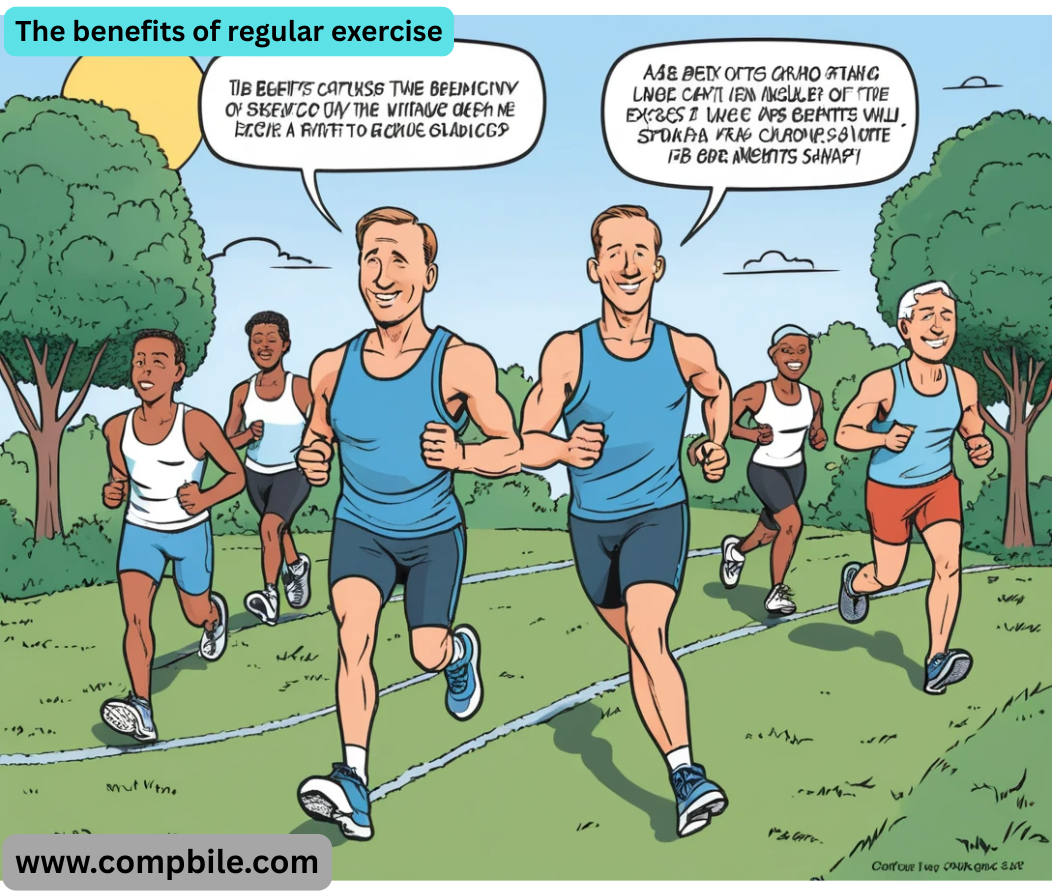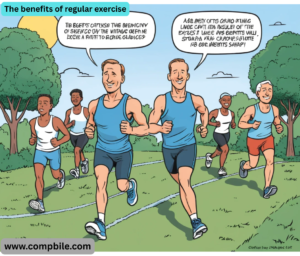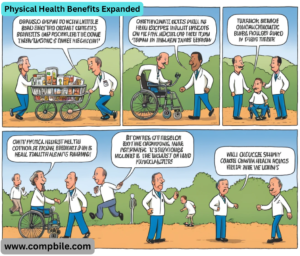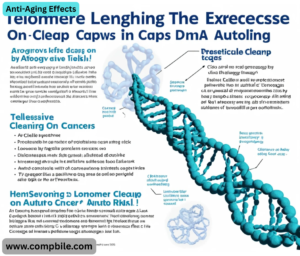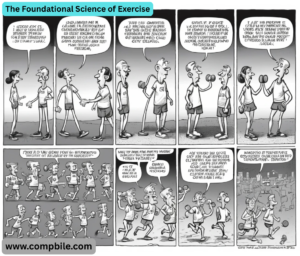The benefits of regular exercise Exercise also boosts energy, enhances muscle and bone strength, and aids in weight management. Mentally, it reduces stress, improves mood, and promotes better sleep, contributing to overall well-being.
Physical Benefits:
- Helps Maintain a Healthy Weight – Burns calories and boosts metabolism, aiding in weight management.
- Enhances Flexibility and Balance – Activities like yoga and stretching improve mobility and reduce the risk of falls, especially in older adults.
- Boosts Immune Function – Regular moderate exercise can strengthen the immune system, helping the body fight off illnesses.
- Increases Energy Levels – Improves endurance and reduces fatigue by enhancing oxygen and nutrient delivery to tissues.
- Promotes Better Sleep – Helps regulate sleep patterns and improves sleep quality.
- Reduces Risk of Chronic Diseases – Lowers the risk of type 2 diabetes, certain cancers, and metabolic disorders.
Mental and Emotional Benefits:
- Reduces Stress and Anxiety – Physical activity triggers the release of endorphins, which help alleviate stress and improve mood.
- Enhances Cognitive Function – Improves memory, focus, and brain health by increasing blood flow to the brain.
- Boosts Self-Esteem and Confidence – Achieving fitness goals and improving physical appearance can enhance self-worth.
- Encourages Social Interaction – Group exercises or team sports provide opportunities for social engagement, reducing feelings of loneliness.
Long-Term Benefits:
- The benefits of regular exercise Improves Quality of Life – Enhances overall well-being, independence, and daily functioning.
How Much Exercise is Recommended?
- Adults: At least 150 minutes of moderate aerobic activity (like brisk walking) or 75 minutes of vigorous activity (like running) per week, plus muscle-strengthening exercises twice a week.
- Children & Teens: 60 minutes daily of moderate-to-vigorous activity.
Physical Health Benefits Expanded
A. Heart & Circulatory System
- Improves blood vessel function, reducing plaque buildup and atherosclerosis.
- Regulates blood sugar, decreasing insulin resistance (key for preventing diabetes).
B. Musculoskeletal System
- Prevents sarcopenia (age-related muscle loss) through resistance training.
- Protects joints by strengthening surrounding muscles (e.g., squats for knee health).
- Reduces back pain via core-strengthening exercises (planks, yoga).
C. Respiratory Efficiency
- Increases lung capacity (e.g., aerobic exercises like swimming or running).
- Helps manage respiratory conditions like asthma (with doctor approval).
D. Metabolic Boost
- EPOC effect (“afterburn”): Intense workouts keep metabolism elevated for hours post-exercise.
- Supports gut health: Exercise promotes microbiome diversity, aiding digestion.
Mental & Cognitive Benefits (Expanded)
A. Brain Health
- May delay neurodegenerative diseases like Alzheimer’s (studies show active adults have a 30% lower risk).
B. Mental Resilience
- Acts as a natural antidepressant by increasing serotonin and dopamine.
- Reduces PTSD symptoms through mindful movement (e.g., tai chi).
C. Productivity & Creativity
- The benefits of regular exercise 20-minute workouts can enhance focus for up to 2 hours post-exercise.
Social & Lifestyle Benefits
- Community building: Joining sports teams or group classes fosters connections.
- Discipline transfer: Regular exercisers often adopt healthier habits (e.g., better sleep, nutrition).
Overcoming Barriers
- Chronic pain? Low-impact options like swimming or Pilates.
- Boredom? Switch activities weekly (e.g., dance classes, rock climbing).
Science-Backed Tips for Success
- Morning workouts may burn more fat (fasted state).
- Music boosts endurance by up to 15%.
- Accountability works: Partnering with a friend increases adherence by 95%.
Anti-Aging Effects
- Telomere Lengthening: Aerobic exercise slows cellular aging by preserving telomeres (protective caps on DNA) – linked to longer lifespans
- Autophagy Boost: Intense exercise triggers autophagy (“cellular cleanup”), removing damaged proteins and reducing cancer risk
Hormonal Optimization
- Irisin Release: Exercise releases this “exercise hormone,” which converts white fat into calorie-burning brown fat.
Brain & Nervous System Enhancements
A. Neuroplasticity
- Dendritic Branching: Aerobic exercise grows new neural connections, improving learning speed by 20%
- Grey Matter Density: Strength training increases grey matter in memory-related areas (hippocampus) in older adults.
B. Mental Performance Hacks
- Pre-Workout Caffeine: Pairing coffee with exercise boosts BDNF 2x more than exercise alone (Journal of Applied Physiology).
- Cold Exposure Combo: Alternating sauna sessions with workouts may enhance myelin sheath production (nerve insulation).
4. Circadian Rhythm Optimization
- The benefits of regular exercise Morning Exercise: Synchronizes cortisol rhythm, improving energy all day.
- Evening Workouts: Resistance training after 4 PM yields greater strength gains (muscle temp peaks late afternoon).
- Avoid Late HIIT: Can disrupt sleep via cortisol spikes; opt for yoga instead.
Gut-Brain Axis Connection
- Microbiome Diversity: Endurance exercisers have 40% more beneficial gut bacteria (Gut Microbes journal).
- Reduced Inflammation: Regular exercise lowers LPS (inflammatory gut toxins) by 30%.
Gender-Specific Benefits
Women
- PCOS Management: 30 mins of daily exercise reduces insulin resistance by 25%.
Men
- Erectile Function: Cardio improves blood flow as effectively as Viagra in some cases (AJM study).
- Prostate Health: Vigorous exercise lowers prostate cancer risk by 34%.
Psychological “Cheat Codes”
- “Exercise Snacking”: Three 1-minute bursts of stair climbing daily improve VO2 max by 5% in 6 weeks.
- Green Exercise: Outdoor workouts reduce rumination (overthinking) by 60% vs. indoors (Scientific Reports).
- Cold Showers Post-Workout: May enhance dopamine by 250% for 3+ hours.
Longevity “Sweet Spot”
- Dose-Response Curve: 150-300 mins/week of moderate exercise delivers 80% of mortality risk reduction – beyond that, returns diminish (JAMA meta-analysis).
- Strength = Survival: Grip strength predicts longevity better than blood pressure in seniors.
Practical Implementation Framework
- Strength Days → Prioritize compound lifts (deadlifts, pull-ups).
- Metabolic Days → VO2 max intervals (e.g., 4×4 mins @ 90% effort).
- Mobility Days → Animal flow or dynamic stretching.
Cutting-Edge Future Trends
- Blood Flow Restriction (BFR) Training: Builds muscle with 20% of usual weight (ideal for rehab).
- Exogenous Ketones + Exercise: May enhance endurance performance by 5-15%.
- Digital Twins: AI-powered avatars that predict your ideal workout based on genetics.
The Foundational Science of Exercise
Mitochondrial Biogenesis
- The benefits of regular exercise Exercise stimulates the creation of new mitochondria (cellular power plants), enhancing energy production and reducing fatigue.
- Best for this: High-intensity interval training (HIIT), endurance sports.
Epigenetic Modifications
- Physical activity alters gene expression, turning on “health-promoting” genes and silencing disease-related ones.
- Example: Exercise can downregulate genes linked to obesity and inflammation.
The Neuroscience of Movement
Neurotransmitter Supercharge
- Dopamine: Surges during/after exercise → motivation & focus.
GABA: Calms anxiety (especially via yoga).
- Anandamide: “Bliss molecule” released during running (“runner’s high”).
Brain Network Upgrades
- Default Mode Network (DMN): Exercise reduces mind-wandering (linked to depression).
The Dark Side: When Exercise Backfires
- Overtraining Syndrome: Cortisol dysregulation → fatigue, insomnia.
- Cardiac Risk: Extreme endurance athletes may develop atrial fibrosis.
- Addiction: Exercise bulimia (compulsive overtraining) mimics OCD.
- Solution: Periodize training (3 weeks on, 1 week deload).
Ancient Wisdom Meets Modern Science
- Animal Moves (e.g., bear crawls): Boost proprioception + primal strength.
- Tummo Breathing (used by monks): Increases cold tolerance + VO2 max.
- Forest Bathing + Hiking: Phytoncides from trees enhance NK cell activity.
The Future of Fitness
- CRISPR-Enhanced Performance (Gene editing for muscle growth – ethical debates ahead).
- Exoskeleton Training (Wearable robots for rehab/superhuman feats).
- VR Workouts (Meta’s “Supernatural” burns 20% more calories than traditional cardio).

